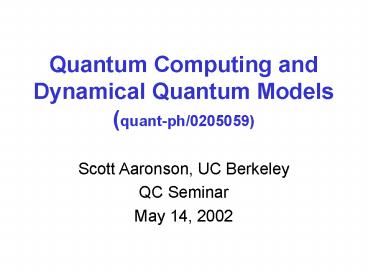Quantum Computing and Dynamical Quantum Models (quant-ph/0205059) - PowerPoint PPT Presentation
Title:
Quantum Computing and Dynamical Quantum Models (quant-ph/0205059)
Description:
... and Dynamical Quantum Models (quant-ph/0205059) Scott Aaronson, ... (submitted to PRL, quant-ph/0205059) What if you could examine an observer's entire history? ... – PowerPoint PPT presentation
Number of Views:67
Avg rating:3.0/5.0
Title: Quantum Computing and Dynamical Quantum Models (quant-ph/0205059)
1
Quantum Computing and Dynamical Quantum
Models(quant-ph/0205059)
- Scott Aaronson, UC Berkeley
- QC Seminar
- May 14, 2002
2
Talk Outline
- Why you should worry about quantum mechanics
- Dynamical models
- Schrödinger dynamics
- SZK ? DQP
- Search in N1/3 queries (but not fewer)
3
(No Transcript)
4
A Puzzle
- Let OR? you seeing a red dot
- OB? you seeing a blue dot
5
Why Is This An Issue?
- Quantum theory says nothing about multiple-time
or transition probabilities
- Reply
- But we have no direct knowledge of the past
anyway, just records
- But then what is a prediction, or the output
of a computation, or the utility of a decision?
6
When Does This Arise?
- When we consider ourselves as quantum systems
- Not in explicit-collapse models
- Bohmian mechanics asserts an answer, but assumes
a specific state space
7
Summary of Results
(submitted to PRL, quant-ph/0205059)
- What if you could examine an observers entire
history? Defined class DQP
- SZK ? DQP. Combined with collision lower bound,
implies oracle A for which BQPA ? DQPA
- Can search an N-element list in order N1/3
steps, though not fewer
8
Dynamical Model
- Given N?N unitary U and state ? acted on,
returns stochastic matrix SD(?,U)
- Must marginalize to single-time probabilities
diag(?) and diag(U?U-1)
- Produces history for one N-outcome von Neumann
observable (i.e. standard basis)
- Discrete time and state space
9
Axiom Symmetry
D is invariant under relabeling of basis
states D(P?P-1,QUP-1) QD(?,U)P-1
10
Axiom Locality
?1??2 ? P1?P2
U
S
Partition U into minimal blocks of nonzero entries
Locality doesnt imply commutativity
11
Axiom Robustness
1/poly(N) change to ? or U ? 1/poly(N) change to
S
12
Example 1 Product Dynamics
Symmetric, robust, commutative, but not local
13
Example 2 Dieks Dynamics
Symmetric, commutative, local, but not robust
14
Example 3 Schrödinger Dynamics
15
Schrödinger Dynamics (cont)
- Theorem Iterative process converges. (Uses
max-flow-min-cut theorem.)
- Theorem Robustness holds.
- Also symmetry and locality
- Commutativity for unentangled states only
16
Computational Model
- Initial state 0??n
- Apply poly-size quantum circuits U1,,UT
- Dynamical model D induces history v1,,vT
- vi basis state of Ui?U10??n that youre in
17
DQP
- ?(D) Oracle that returns sample v1,,vT, given
U1,,UT as input (under model D)
- DQP Class of languages for which theres one
BQP?(D) algorithm that works for all symmetric
local D
- BQP ? DQP ? PP
18
DQP
BQP
SZK
BPP
19
SZK?DQP
- Suffices to decide whether two distributions are
close or far (Sahai and Vadhan 1997) - Examples graph isomorphism, collision-finding
20
Why This Worksin any symmetric local model
Let v1x?, v2z?. Then will v3y? with high
probability? Let F x? ? 2-n/2 ?w (-1)x?ww? be
Fourier transform Observation x ? z ? y ? z (mod
2) Need to show F is symmetric under some
permutation of basis states that swaps x? and
y? while leaving z? fixed Suppose we had an
invertible matrix M over (Z2)n such that Mxy,
Myx, MTzz Define permutations ?,? by ?(x)Mx
and ?(z)(MT)-1z then ?(x) ? ?(z) ?
xTMT(MT)-1z ? x ? z (mod 2) Implies that F is
symmetric under application of ? to input basis
states and ?-1 to output basis states
21
Why M Exists
Assume x and y are nonzero (they almost certainly
are) Let a,b be unit vectors, and let L be an
invertible matrix over (Z2)n such that Lax and
Lby Let Q be the permutation matrix that
interchanges a and b while leaving all other unit
vectors fixed Set M LQL-1 Then Mxy,
Myx Also, x?z ? y?z (mod 2) implies aTLTz
bTLTz So QT(LTz) LTz, implying MTz z
22
When Input Isnt Two-to-One
- Append hash register h(x)? on which Fourier
transforms dont act
- Choose h uniformly from all functions
- 0,1n ? 1,,K
- Take K1 initially, then repeatedly double K and
recompute h(x)?
- For some K, reduces to two-to-one case with high
probability
23
N1/3 Search Algorithm
N1/3 Grover iterations
24
Concluding Remarks
- N1/3 bound is optimal NPA ? DQPA for an oracle A
- With direct access to the past, you could decide
graph isomorphism in polytime, but probably not
SAT
- Contrast Nonlinear quantum theories could
decide NP and even P in polytime (Abrams and
Lloyd 1998)
- Dynamical models more reasonable?































